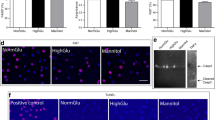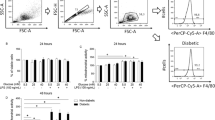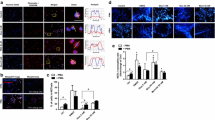Abstract
Purpose
Diabetes mellitus (DBM) reduces immunological activity and increases susceptibility to various infections, including tuberculosis (TB). Human alveolar macrophage (hAM) functions are altered in DBM.
Methods
To mimic hyperglycemic conditions in the lung alveolus, we co-cultured a hAM cell line (Daisy cell line) with human umbilical vein endothelial cells for 48 h in the presence of culture media alone, normal glucose (5 mM), and high glucose (22 mM). Using flow cytometry, immunophenotype characterization included cell surface markers CD 11c, CD14, CD16, CD86, CD163, CD169, CD206, CX3CR-1, CSF-1R, and matrix metalloproteinase-9 (MMP9). Phagocytic function was measured by immunofluorescence microscopy at 24 h after inoculation of cells with GFP-expressing Mycobacterium smegmatis.
Results
Direct exposure of AMs to high glucose and exposure in the co-culture system yield different results for the same phenotypic markers. MMP9 expression was increased under both conditions. CD169 and CX3CR1 expressions were decreased when AMs were exposed directly to high glucose but increased under co-culture. Immunofluorescence assay revealed that phagocytosis decreased in AMs when directly exposed to increased glucose levels from 2.5 mM to normal glucose (5 mM), yet AMs under co-culture did not show decreased phagocytosis until concentrations were raised to 25 mM.
Conclusion
Alteration in the expression of certain receptors may contribute to defective sentinel function of AMs, promoting susceptibility to TB in a diabetic host. Variability in cell surface marker expression under direct glucose exposure compared to exposure via co-culture reveals that cell signaling between endothelial cells and AMs may play a crucial role in the phenotypic expression of AMs.


Similar content being viewed by others
References
Donoghue HD, Spigelman M, Greenblatt CL, Lev-Maor G, Bar-Gal GK, Matheson C, Vernon K, Nerlich AG, Zink AR (2004) Tuberculosis: from prehistory to Robert Koch, as revealed by ancient DNA. Lancet Infect Dis 4(9):584–592. https://doi.org/10.1016/S1473-3099(04)01133-8
World Health Organization (2018) Global tuberculosis report 2018. WHO, Geneva
McCarthy M (2014) Nearly one in 10 US residents has diabetes, CDC reports. BMJ 348:g3962. https://doi.org/10.1136/bmj.g3962
Hall JE (2016) Guyton and Hall textbook of medical physiology, 13th edn. Saunders, Philadelphia
Montoya-Rosales A, Castro-Garcia P, Torres-Juarez F, Enciso-Moreno JA, Rivas-Santiago B (2016) Glucose levels affect LL-37 expression in monocyte-derived macrophages altering the Mycobacterium tuberculosis intracellular growth control. Microb Pathog 97:148–153. https://doi.org/10.1016/j.micpath.2016.06.002
Brennan AL, Gyi KM, Wood DM, Johnson J, Holliman R, Baines DL, Philips BJ, Geddes DM, Hodson ME, Baker EH (2007) Airway glucose concentrations and effect on growth of respiratory pathogens in cystic fibrosis. J Cyst Fibros 6(2):101–109. https://doi.org/10.1016/j.jcf.2006.03.009
Kumar V, Abbas AK, Aster JC (2015) Robbins & Cotran pathologic basis of disease. Robbins pathology, 9th edn. Elsevier Health Sciences, London
Young B, Woodford P, O’Dowd G (2014) Wheater’s functional histology: a text and colour atlas. Elsevier, Amsterdam
Chavez-Galan L, Olleros ML, Vesin D, Garcia I (2015) Much more than M1 and M2 macrophages, there are also CD169(+) and TCR(+) macrophages. Front Immunol 6:263. https://doi.org/10.3389/fimmu.2015.00263
Cai Y, Sugimoto C, Arainga M, Alvarez X, Didier ES, Kuroda MJ (2014) In vivo characterization of alveolar and interstitial lung macrophages in rhesus macaques: implications for understanding lung disease in humans. J Immunol 192(6):2821–2829. https://doi.org/10.4049/jimmunol.1302269
Roszer T (2015) Understanding the mysterious M2 macrophage through activation markers and effector mechanisms. Mediators Inflamm 2015:816460. https://doi.org/10.1155/2015/816460
Hayman Y, Hart S, Morice A (2014) Characterisation of a new Daisy cell line representative of human alveolar macrophage (hAM). Eur Respir J 38:3859
Ruslami R, Aarnoutse RE, Alisjahbana B, van der Ven AJ, van Crevel R (2010) Implications of the global increase of diabetes for tuberculosis control and patient care. Trop Med Int Health (TM&IH) 15(11):1289–1299. https://doi.org/10.1111/j.1365-3156.2010.02625.x
Li H, Peng W, Jian W, Li Y, Li Q, Li W, Xu Y (2012) ROCK inhibitor fasudil attenuated high glucose-induced MCP-1 and VCAM-1 expression and monocyte-endothelial cell adhesion. Cardiovasc Diabetol 11:65. https://doi.org/10.1186/1475-2840-11-65
American Diabetes Association (2016) Standards of medical care in diabetes—2016 abridged for primary care providers. Clin Diabetes 34(1):3–21. https://doi.org/10.2337/diaclin.34.1.3
de Prost N, Saumon G (2007) Glucose transport in the lung and its role in liquid movement. Respir Physiol Neurobiol 159(3):331–337. https://doi.org/10.1016/j.resp.2007.02.014
Italiani P, Boraschi D (2014) From monocytes to M1/M2 macrophages: phenotypical vs. functional differentiation. Front Immunol 5:514. https://doi.org/10.3389/fimmu.2014.00514
Hall JD, Kurtz SL, Rigel NW, Gunn BM, Taft-Benz S, Morrison JP, Fong AM, Patel DD, Braunstein M, Kawula TH (2009) The impact of chemokine receptor CX3CR1 deficiency during respiratory infections with Mycobacterium tuberculosis or Francisella tularensis. Clin Exp Immunol 156(2):278–284. https://doi.org/10.1111/j.1365-2249.2009.03882.x
Wolf Y, Yona S, Kim KW, Jung S (2013) Microglia, seen from the CX3CR1 angle. Front Cell Neurosci 7:26. https://doi.org/10.3389/fncel.2013.00026
Yu YR, Hotten DF, Malakhau Y, Volker E, Ghio AJ, Noble PW, Kraft M, Hollingsworth JW, Gunn MD, Tighe RM (2016) Flow cytometric analysis of myeloid cells in human blood, bronchoalveolar lavage, and lung tissues. Am J Respir Cell Mol Biol 54(1):13–24. https://doi.org/10.1165/rcmb.2015-0146OC
Cicek BB, Khanna KM (2016) Discovery of a novel subset of lung resident macrophages that regulate pathogen clearance and immune homeostasis after respiratory infection. J Immunol 196:68.61–68.61
Bogie JF, Boelen E, Louagie E, Delputte P, Elewaut D, van Horssen J, Hendriks JJ, Hellings N (2017) CD169 is a marker for highly pathogenic phagocytes in multiple sclerosis. Mult Scler 24(3):290–300. https://doi.org/10.1177/1352458517698759
Wang XW, Liu JJ, Wu QN, Wu SF, Hao DJ (2017) The in vitro and in vivo effects of microRNA-133a on intervertebral disc destruction by targeting MMP9 in spinal tuberculosis. Life Sci 188:198–205. https://doi.org/10.1016/j.lfs.2017.07.022
Coussens A, Timms PM, Boucher BJ, Venton TR, Ashcroft AT, Skolimowska KH, Newton SM, Wilkinson KA, Davidson RN, Griffiths CJ, Wilkinson RJ, Martineau AR (2009) 1alpha,25-dihydroxyvitamin D3 inhibits matrix metalloproteinases induced by Mycobacterium tuberculosis infection. Immunology 127(4):539–548. https://doi.org/10.1111/j.1365-2567.2008.03024.x
Jager NA, Wallis de Vries BM, Hillebrands JL, Harlaar NJ, Tio RA, Slart RH, van Dam GM, Boersma HH, Zeebregts CJ, Westra J (2016) Distribution of matrix metalloproteinases in human atherosclerotic carotid plaques and their production by smooth muscle cells and macrophage subsets. Mol Imaging Biol 18(2):283–291. https://doi.org/10.1007/s11307-015-0882-0
Acknowledgements
Special thanks to Dr. Nicolai van Oers (UT Southwestern) for supplying the GFP-expressing M. smegmatis. This study was supported by Texas Tech University Health Sciences Center (US) (Grant No. Mini SARP Grant).
Author information
Authors and Affiliations
Corresponding author
Ethics declarations
Conflict of interest
The authors declare that they have no conflict of interest.
Electronic supplementary material
Below is the link to the electronic supplementary material.
Rights and permissions
About this article
Cite this article
Vance, J., Santos, A., Sadofsky, L. et al. Effect of High Glucose on Human Alveolar Macrophage Phenotype and Phagocytosis of Mycobacteria. Lung 197, 89–94 (2019). https://doi.org/10.1007/s00408-018-0181-z
Received:
Accepted:
Published:
Issue Date:
DOI: https://doi.org/10.1007/s00408-018-0181-z




